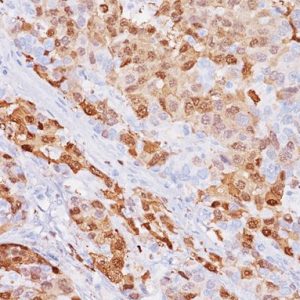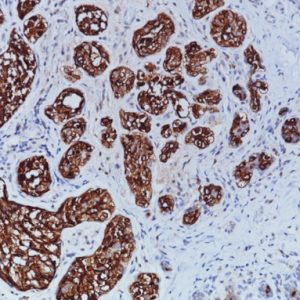Description
High molecular weight cytokeratins are expressed in a variety of normal and neoplastic epithelial tissues (1). In prostate, CK HMW [34βE12] has been shown to be a useful marker of basal cells of normal glands and prostatic intraepithelial neoplasia (PIN), a precursor lesion to prostatic adenocarcinoma; whereas invasive prostatic adenocarcinoma typically lacks a basal cell layer (2-4).
p63, a homolog of the tumor suppressor p53, has been identified in proliferating basal cells in the epithelial layers of a variety of tissues, including epidermis, cervix, urothelium and prostate (5). p63 was detected in nuclei of the basal epithelium in normal prostate glands; however, it was not expressed in malignant tumors of the prostate (6).
α-Methylacyl coenzyme A racemase (AMACR), also known as P504S, is a peroxisomal and mitochondrial enzyme that plays a role in bile acid synthesis and β-oxidation of branched chain fatty acids (7). AMACR was initially identified from a cDNA library as a gene that is overexpressed in human prostate cancer; with little or no expression in normal prostate (8,9). In immunohistochemistry, AMACR has been shown to be a specific marker of prostatic adenocarcinoma (8-11). Additionally, prostate glands involved in PIN have been found to express AMACR, whereas AMACR was nearly undetectable in benign glands (11,12).
Studies have shown that combinations of CK HMW [34βE12], p63, and/or AMACR may be useful in the evaluation of normal prostate glands, PIN and prostatic adenocarcinoma (13,14).
U.S. Patent 8,603,765 and patents pending.
Formerly known as PIN-4®
SPECIFICATIONS
Specifications
| INTENDED USE | IVD |
|---|---|
| SOURCE | Mouse Monoclonal, Rabbit Monoclonal |
| CLONE | 13H4, 34BE12, 4A4 |
| ISOTYPE | IgG, IgG1/kappa, IgG2a/kappa |
| ANTIGEN | AMACR, CK HMW, p63 |
| LOCALIZATION | Cytoplasmic, Nuclear |
| POSITIVE CONTROL | Normal prostate adenocarcinoma |
| SPECIES REACTIVITY | Human; others not tested |
DATASHEETS & SDS
REFERENCES
1. Moll R, et al. The catalog of human cytokeratins: patterns of expression in normal epithelia, tumors and cultures cells. Cell. 1982 Nov; 31(1):11-24.
2. Bostwick DG, Qian J. High-grade prostatic intraepithelial neoplasia. Mod Pathol. 2004 Mar; 17(3):360-79.
3. Humphrey PA. Diagnosis of adenocarcinoma in prostate needle biopsy tissue. J Clin Pathol. 2007 Jan; 60(1):35-42.
4. Shah RB, et al. Comparison of the basal cell-specific markers, 34betaE12 and p63, in the diagnosis of prostate cancer. Am J Surg Pathol. 2002 Sep; 26(9):1161-8.
5. Yang A, et al. p63, a p53 homolog at 3q27–29, encodes multiple products with transactivating, death-inducing, and dominant-negative activities. Mol Cell. 1998 Sep; 2(3):305-16.
6. Signoretti S, et al. p63 is a prostate basal cell marker and is required for prostate development. Am J Pathol. 2000 Dec; 157(6):1769-75.
7. Ferdinandusse S, et al. Subcellular localization and physiological role of alphamethylacyl- CoA racemase. J Lipid Res. 2000 Nov; 41(11):1890-6.
8. Xu J, et al. Identification of differentially expressed genes in human prostate cancer using subtraction and microarray. Cancer Res. 2000 Mar 15; 60(6):1677-82.
9. Rubin MA, et al. alpha-Methylacyl coenzyme A racemase as a tissue biomarker for prostate cancer. JAMA. 2002 Apr 3; 287(13):1662-70.
10. Luo J, et al. Alpha-methylacyl-CoA racemase: a new molecular marker for prostate cancer. Cancer Res. 2002 Apr 15; 62(8):2220-6.
11. Zhou M, et al. Alpha-Methylacyl-CoA racemase: a novel tumor marker overexpressed in several human cancers and their precursor lesions. Am J Surg Pathol. 2002 Jul; 26(7):926-31.
12. Wu CL, et al. Analysis of alpha-methylacyl-CoA racemase (P504S) expression in high-grade prostatic intraepithelial neoplasia. Hum Pathol. 2004 Aug; 35(8):1008-13.
13. Shah RB, et al. Usefulness of basal cell cocktail (34betaE12 + p63) in the diagnosis of atypical prostate glandular proliferations. Am J Clin Pathol. 2004 Oct; 122(4):517 -23.
14. Sung MT, et al. Alpha-methylacyl-CoA racemase (P504S)/34betaE12/p63 triple cocktail stain in prostatic adenocarcinoma after hormonal therapy. Hum Pathol. 2007 Feb; 38(2):332-41.
15. Center for Disease Control Manual. Guide: Safety Management, NO. CDC-22, Atlanta, GA. April 30, 1976 “Decontamination of Laboratory Sink Drains to Remove Azide Salts.”
16. Clinical and Laboratory Standards Institute (CLSI). Protection of Laboratory Workers from Occupationally Acquired Infections; Approved Guideline-Fourth Edition CLSI document M29-A4 Wayne, PA 2014.







Reviews
There are no reviews yet.